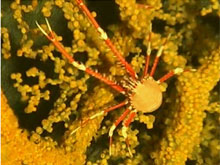
A large galathaeid crab sits on a gold coral tree. Galathaeids are one of the larger and more abundant invertebrates we find in association with deep-sea corals. Click image for larger view and image credit.
Deep Sea Precious Corals as Habitat for Macroinvertebrates in Hawaii
October 2 - 18, 2004
Amy Baco-Taylor
Visiting Investigator, Biology Department
Woods Hole Oceanographic
Institution
When diving on deep-sea corals beds, it is hard not to notice the many invertebrataes that are associated with the corals. Deep-sea gorgonian corals provide habitat for many other creatures because corals add habitat complexity, altering the seafloor by adding a large structure for other organisms to climb up on to reach higher into the water column. Many of these organisms are also suspension feeders, like the corals. The higher up they get into the water column, the more food they will find. We find many invertebrates—including brittle stars, basket stars, crinoids (sea lilies), polychaetes, galathaeid crabs, and sponges—living on coral trees.
Few studies have focused specifically on the assemblages associated with deep-sea coral species. Submersible observations of precious corals and other gorgonians found in the precious corals beds on several islands and seamounts in the Hawaiian Archipelago have shown that a number of species may inhabit a single coral tree. Additionally, it appears that each species of coral consistently harbors different characteristic species. Despite these observations, none of these fauna have been quantified, and few have been identified. On this cruise, we will examine the coral-associated invertebrate fauna at three large precious coral beds in the Hawaiian Archipelago, the Makapu’u Bed, on the southeast slope of Oahu, the Keahole Bed, on the western slope of Hawaii, and the Cross Seamount Bed. The most abundant coral species in these three beds are the pink coral, Corallium secundum, the red coral Corallium regale, and the gold coral Gerardia sp. These species are concentrated at depths of 300-500m. We will collect and identify coral-associated invertebrates to use for species identification and to determine community structure. We will also compare the lists of invertebrate species associated with each coral species to determine if certain invertebrates prefer to live on certain species of corals.



